The popular minhwa of today does not faithfully adhere to the genre’s traditional hues and designs. In expressing current interests and desires, the 21st century versions of folk painting are transformative.
Until a few decades ago, minhwa evoked limited appreciation. The 1970s and 1980s had easily identifiable enthusiasts. They included art dealers from abroad, most notably from Japan, and a handful of deluxe hotels. They would purchase items from subsets of Korean folk art, such as morando (paintings of peonies), sipjangsaengdo (paintings of ten longevity symbols) and kkachi horangi (paintings of magpies and a tiger). Today, minhwa is reaching a much wider audience. The genre is a cherished hobby for many people and represents a fresh and profitable approach to product design for fashion and cosmetics companies.
Individual artists with small workshops triggered the propagation of folk painting. In the 1990s, many of these artists expanded their operations by taking folk painting to college-based institutes for lifelong education or the cultural centers of major department stores. Novice painters honed their skills by tracing the outlines of well-known paintings and a folk art community began to develop.
In the 2000s, the number of practicing artists increased sharply and their skills improved dramatically. Those who had struggled to express modern sensibilities and values while adhering to the old formats even began to reformulate their approach into new styles.
Keum Goang-bok is proficient in both the traditional and creative styles of minhwa. His humorous portrayal of the tiger, deemed to have talismanic power, reflects protection of Korean culture. “Just as minhwa was derived from our ancestors’ everyday life, contemporary works should also tell our current stories,” says Keum. “For the constant development of this art, our work should convey not just blissful messages but historical awareness as well.”
Ahn Seong-min (aka Seongmin Ahn), who is active in both Seoul and New York, is known for the surreal aura that pervades her paintings of flowers and the doors and windows of brownstones, an architectural style common in New York. In her so-called “noodle landscapes,” an awe-inspiring natural scene is combined with the daily food item.
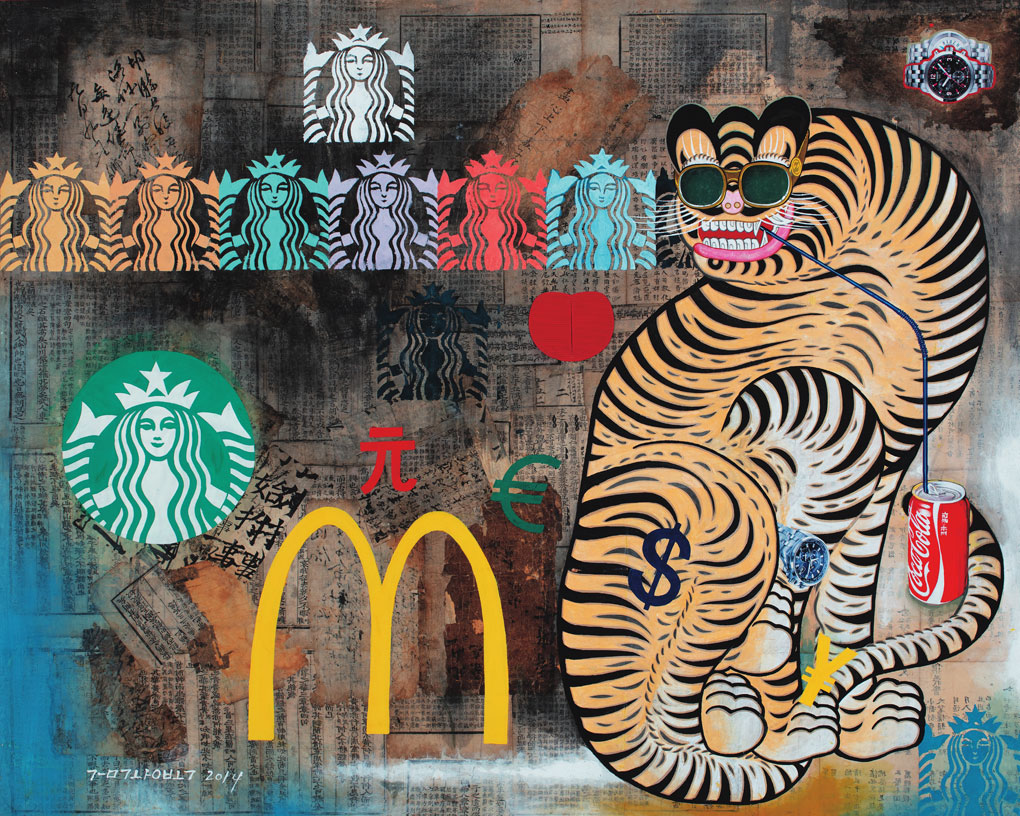
“Modern Tiger.” Keum Goang-bok. 2020. Ink and pigments on mulberry paper
(stick, powder, tube paints, Chinese white powder). 130 × 160 cm.
Contemporary Narratives
Kim Saeng-a avidly incorporates the local scenery and folk tales of Jeju Island, where she resides. Her objets d’art include glass shards collected from beachcombing and fired in a kiln. Her message is that “small things like collecting discarded glass on the beach could make a meaningful change for beautiful Jeju, which suffers from environmental pollution.”
Various stylistic experiments using minhwa iconography – e.g. repeating specific patterns as in wallpapers or presenting fictional characters from the paintings – have been attempted to stimulate viewers’ curiosity and sensibilities. Employing gestalt shift technique (which allows an image to be perceived in two different ways depending on perspective), “Flowery Path” by Lee Jee-eun displays the artist’s extraordinary sensibility and insight into her subjects. “A skull is usually associated with death and evokes a negative affect,” she explained. “But I thought a person who’d led a beautiful life would leave a beautiful skull. That’s why I painted it this way.”
Another significant experiment involves employing a small part of an existing painting to fill an entire canvas. In “Bookshelf,” Yoon In-soo offers a close-up image of a flower vase extracted from a typical work of the genre called chaekgado (bookshelves). The effect is extraordinary, enlivening the vase’s beautiful color and shape, which otherwise would barely have been noticed. To grasp the essence of minhwa, Yoon underwent intense training at a craft workshop. As such, he always tells his students, “Mastering traditional styles is key to the successful creation of new ones.”
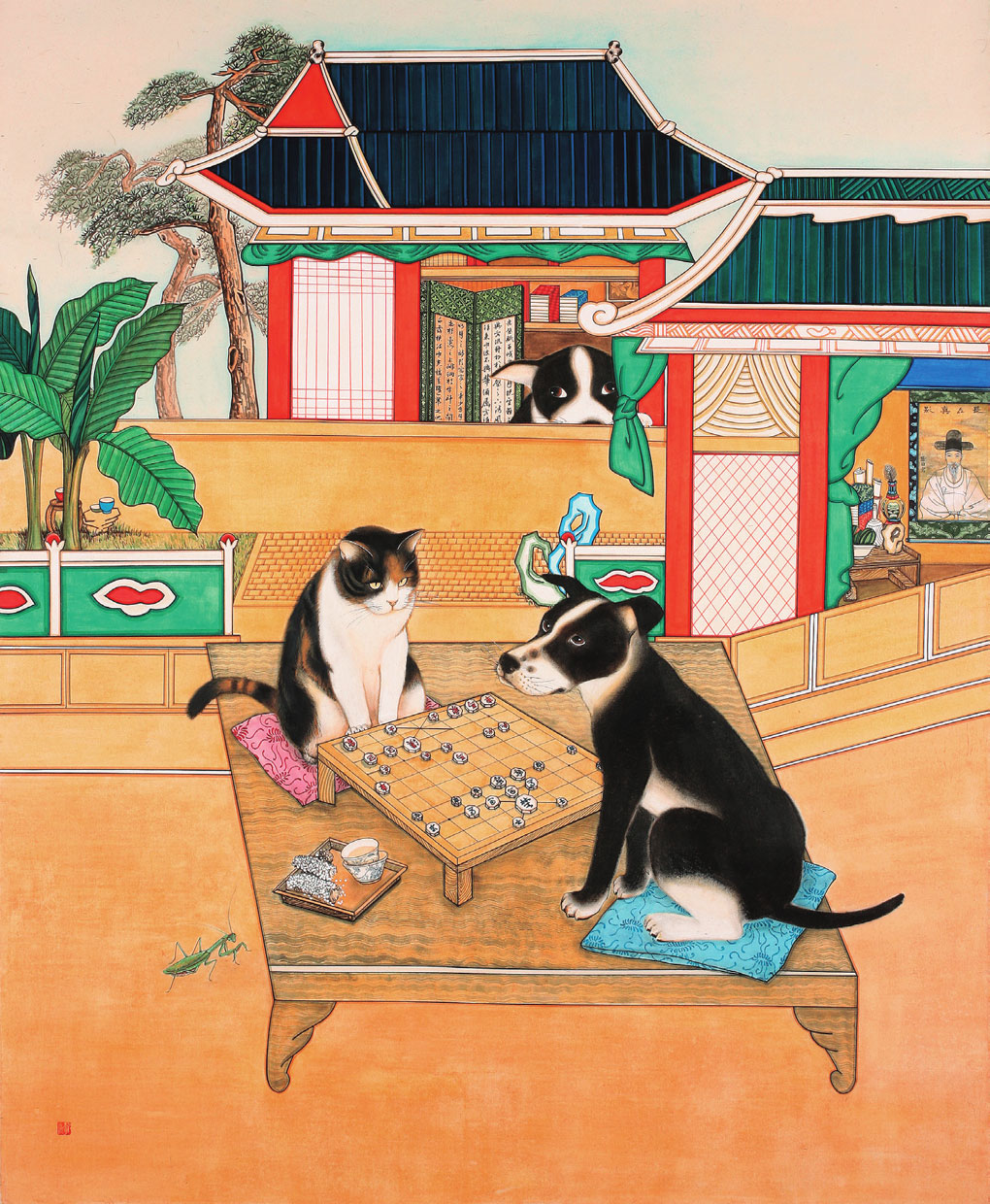
“Friends at First Sight.” Kwak Su-yeon. 2010. Ink and color on mulberry paper. 162 × 131 cm.
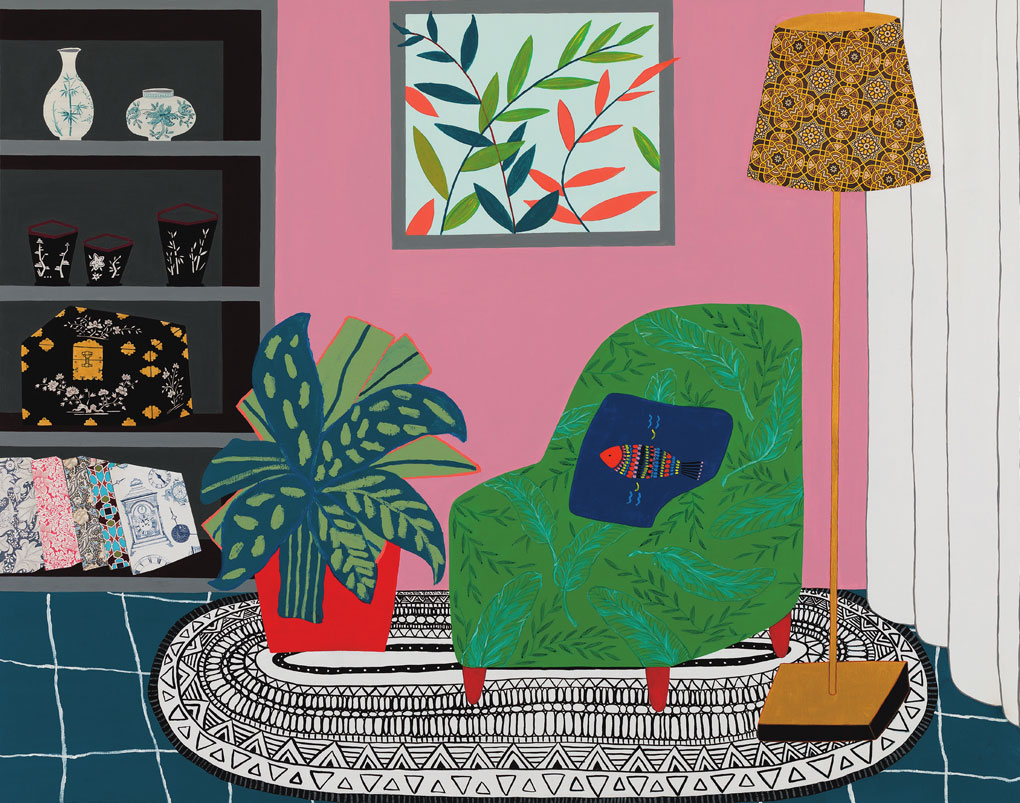
“Spielraum No.5.”
Choi Seo-won. 2020. Mixed media on canvas. 91 × 116.8 cm.
New Experiments
Some artists adopt characters depicted in their paintings as their personae while others use well-known fictional characters – e.g. the Little Prince from Saint-Exupéry’s novella of the same title – to make their art appealing to a wider audience. Kwak Su-yeon is famed for her series of works featuring pets. Her paintings of bookshelves and the ten longevity symbols amuse viewers with their humorous depictions of dogs and cats.
Recently, many contemporary minhwa artists have attempted to depart from traditional pigments on Korean mulberry paper to explore a wider array of materials. Their selection process gives them an opportunity to create their own visual language. These artists agree that in this globalized world, it is meaningless to make a distinction between Eastern and Western materials.
The fact that elements of minhwa have been so widely used by contemporary artists of both Western and Eastern disciplines evinces the popularity of the folk art reborn in the modern era.
Beyond Tradition
Some use acrylic paints, crayons or colored pencils on canvas, while others make collages from fabric, wallpaper or other readily available materials to imbue their works with a modern texture. Some even distance themselves from two-dimensional work altogether. They experiment with formats, including installation and media art. Lee Don-ah was previously known for her images of traditional iconography dismantled and visualized into hexahedrons, quadrangles and square frames. Since 2015, she has been working with media art technologies, such as video images, lenticular printing and media façades, to incorporate them into her paintings.
The fact that elements of minhwa have been so widely used by contemporary artists of both Western and Eastern disciplines evinces the popularity of the folk art reborn in the modern era.
The popularity of minhwa is transcending the art scene to spread across cosmetics, fashion and household goods. Folk paintings have always served the practical purpose of decorating a home. The practicality, decorative quality and uniquely Korean aesthetics inherent in the genre make it highly effective for distinctive product branding.
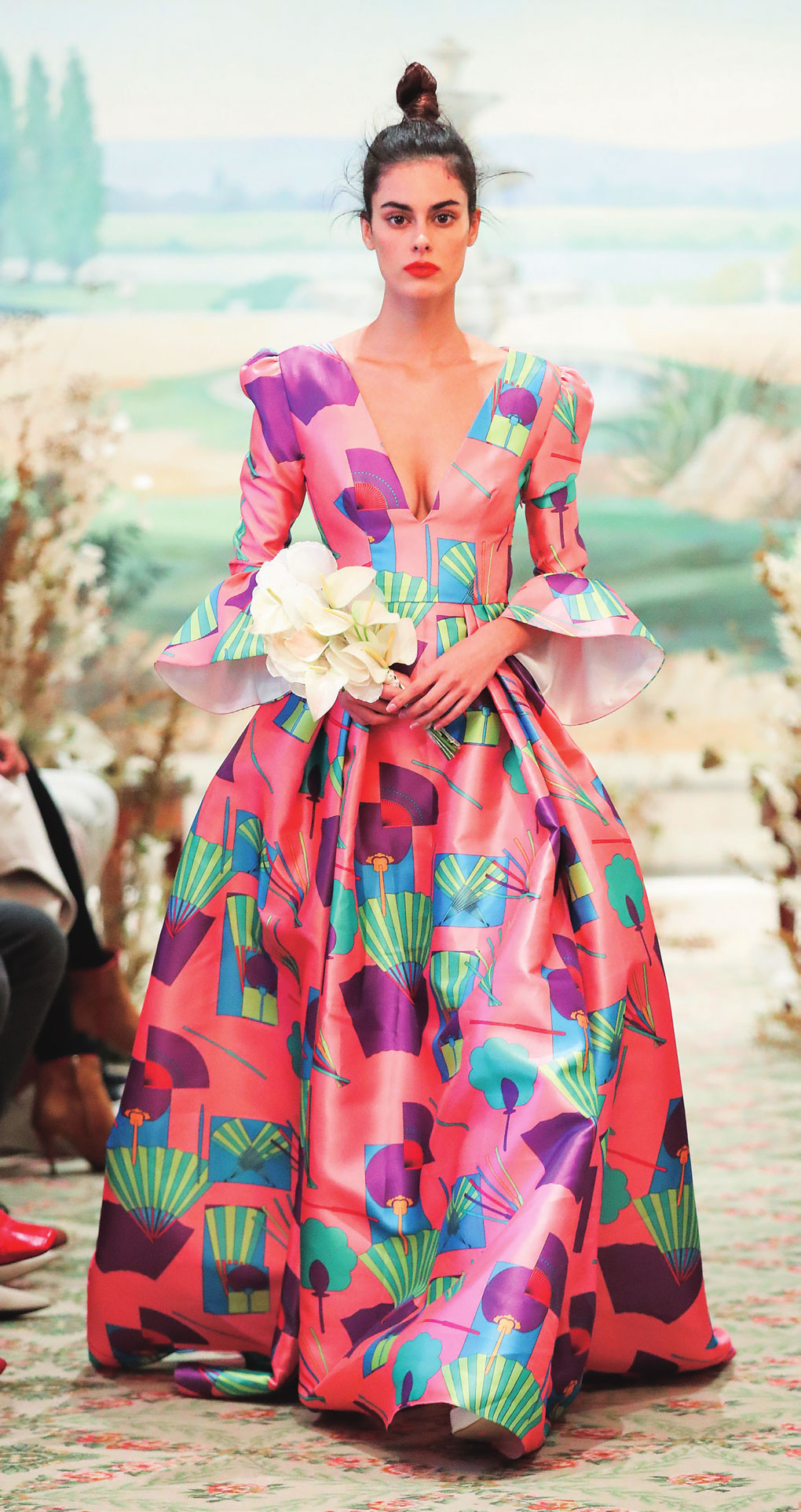
Designer Heill Yang of the fashion brand HEILL introduced this minhwa-inspired dress at Le Bristol Paris during Paris Fashion Week in September 2019.
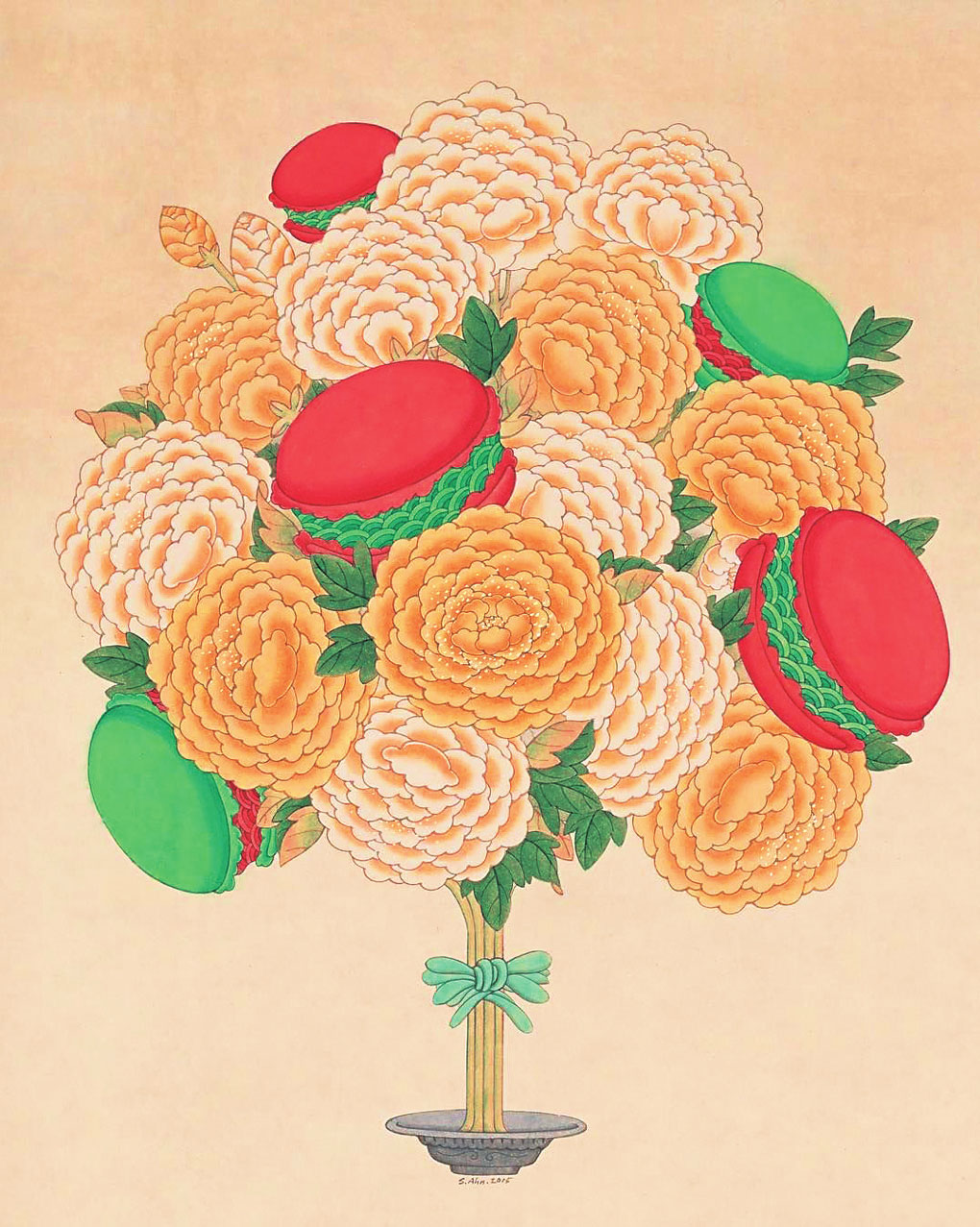
“Peony Pot Macaron 02 (Dessert Bouquet Series).” Ahn Seong-min. 2015. Ink and color on mulberry paper. 75 × 50 cm.
Commercialization
Cosmetics maker Sulwhasoo totally embraces minhwa, with the packaging of its products done in collaboration with renowned artists. In 2019, a Sulwhasoo exhibition displayed a modern reinterpretation of traditional patterns, showcasing works of interior design, furniture and fashion using traditional motifs taken from two folk painting genres, hojeopdo (paintings of butterflies) and hwajo yeongmodo (paintings of flowers, birds and animals).
Heill, an haute-couture brand, presented its Spring/Summer 2020 Collection in Paris with a motif of traditional Korean fans seen in folk paintings. Before the show, designer Heill Yang said, “I’m so happy that we have such a beautiful reservoir of resources in minhwa.” First Lady Kim Jung-sook wore an outfit of his design for the inauguration of President Moon Jae-in in 2017.
Global brands also have taken notice. Minhwa has a beauty that is uniquely Korean but can also easily communicate with the wider world. The auspicious messages and wishes for happiness delivered by the paintings obviously have a universal appeal, which helps explain the genre’s revival. Perhaps this timeless genre may become known as “K-art,” stirring up another Korean Wave of cultural exports through incessant challenge and experimentation.